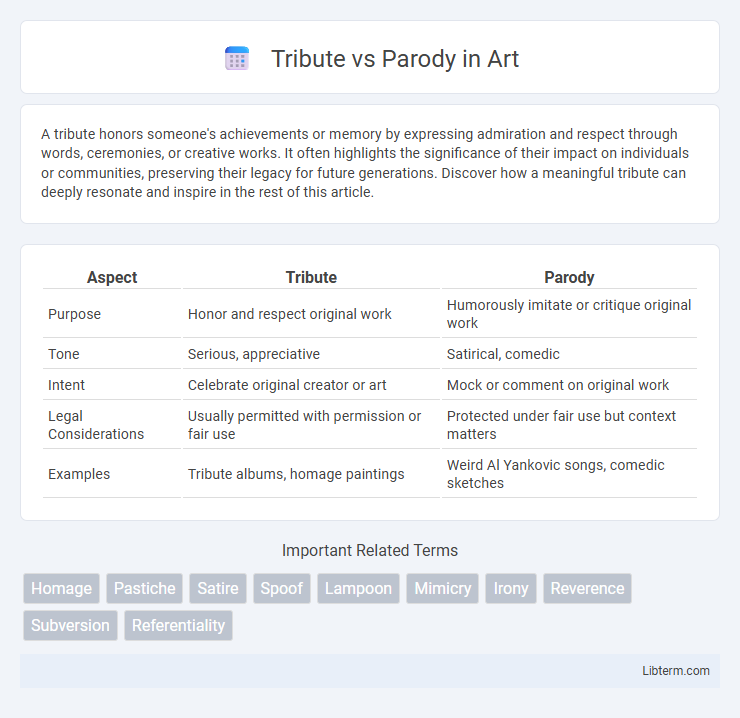A tribute honors someone's achievements or memory by expressing admiration and respect through words, ceremonies, or creative works. It often highlights the significance of their impact on individuals or communities, preserving their legacy for future generations. Discover how a meaningful tribute can deeply resonate and inspire in the rest of this article.
Table of Comparison
| Aspect | Tribute | Parody |
|---|---|---|
| Purpose | Honor and respect original work | Humorously imitate or critique original work |
| Tone | Serious, appreciative | Satirical, comedic |
| Intent | Celebrate original creator or art | Mock or comment on original work |
| Legal Considerations | Usually permitted with permission or fair use | Protected under fair use but context matters |
| Examples | Tribute albums, homage paintings | Weird Al Yankovic songs, comedic sketches |
Understanding Tribute: Definition and Purpose
A tribute is a respectful and genuine acknowledgment or celebration of a person, work, or event, aiming to honor its significance and impact. It often emphasizes admiration, capturing the essence and positive qualities without altering the original meaning or intent. Tributes serve to preserve legacy and foster appreciation while maintaining authenticity and reverence.
Parody Explained: Meaning and Intent
Parody is a creative work that imitates the style or content of another, often to provide commentary, critique, or humor, highlighting original themes in a transformed, exaggerated manner. Its intent centers on entertainment and critique by exaggerating distinctive features to expose underlying meanings or absurdities. Unlike tribute, which honors and respects the original, parody uses satire and irony to provoke thought and engage audiences through mimicry and clever reinterpretation.
Key Differences Between Tribute and Parody
Tribute and parody differ primarily in intent and tone, with tribute expressing admiration and respect toward the subject, often highlighting its positive qualities, while parody uses humor, exaggeration, or satire to critique or mock. Tributes maintain a sincere and celebratory approach, aiming to honor the original work or person, whereas parodies intentionally distort or mimic elements for comedic or critical effect. Key distinctions also involve emotional response elicited; tributes evoke appreciation and nostalgia, whereas parodies provoke laughter or critical reflection.
Historical Roots of Tribute and Parody
Tribute and parody both originate from rich historical traditions that reflect cultural appreciation and critique through imitation. Tribute finds its roots in ancient rituals and ceremonies where homage was paid to deities or leaders through art, reinforcing social values and collective memory. Parody dates back to classical Greece, notably in Aristophanes' plays, as a form of satire used to humorously critique politics, society, and literary works.
Legal Considerations: Copyright and Fair Use
Tributes and parodies differ significantly in legal considerations related to copyright and fair use. Tributes often require permission from copyright holders since they use original content to honor the work, risking infringement without authorization. Parodies, by contrast, typically qualify as fair use because they provide commentary or criticism through transformative elements, allowing limited use of copyrighted material without explicit permission.
Emotional Resonance: Celebratory vs Satirical
Tributes evoke emotional resonance through celebratory tones, honoring the original work with admiration and respect that fosters positive feelings and nostalgia. Parodies create emotional impact by using satirical elements, often employing humor and exaggeration to critique or lampoon the source material, eliciting amusement or critical reflection. The distinct emotional dynamics of tributes and parodies shape audience perception by either reinforcing appreciation or encouraging reevaluation of the original content.
Notable Examples of Memorable Tributes
Notable examples of memorable tributes include Queen's "Bohemian Rhapsody" performance at Live Aid, which honored the spirit of rock and charity. Another significant tribute is Elton John's "Goodbye Yellow Brick Road" concert series, celebrating his musical legacy and influence. These tributes stand out for their emotional impact, authenticity, and deep connection to the original artists' work.
Iconic Parodies That Shaped Pop Culture
Iconic parodies like "Weird Al" Yankovic's music videos and "Saturday Night Live" sketches have significantly shaped pop culture by humorously reinterpreting famous works, creating memorable moments that resonate with audiences worldwide. These parodies often exaggerate the traits of the original material, blending satire with entertainment to critique societal norms or highlight cultural trends. Unlike tributes, which honor and celebrate their subjects earnestly, parodies use irony and humor to provide a fresh perspective, influencing how audiences perceive the original content and its impact.
Audience Reception: Appreciating Tribute vs Parody
Audience reception of tribute and parody varies significantly due to their distinct intentions; tributes evoke admiration and nostalgia by honoring original works, while parodies generate humor through satire and exaggeration. Tribute enthusiasts appreciate faithful renditions that preserve the essence and emotional impact of the source material, fostering a sense of respect and connection. Parody audiences, on the other hand, value clever critique and subversion, finding enjoyment in the playful transformation and commentary on familiar cultural elements.
When Tribute and Parody Overlap
Tribute and parody overlap when both forms reference the original work, blending admiration with comedic imitation to evoke recognition. A tribute emphasizes respect and celebration of the source material, while parody uses exaggeration and satire to critique or entertain. This intersection creates pieces that honor the original while simultaneously providing humor or insight through creative interpretation.
Tribute Infographic

 libterm.com
libterm.com